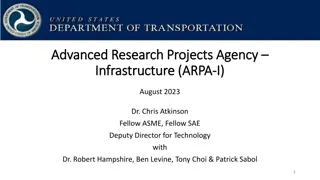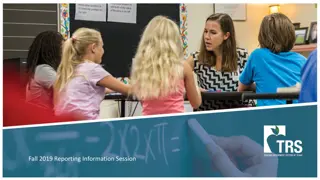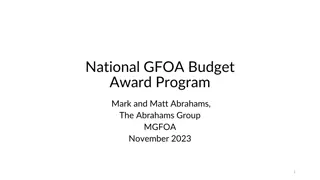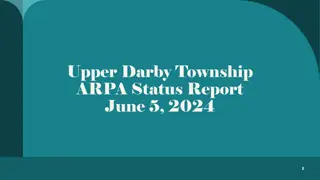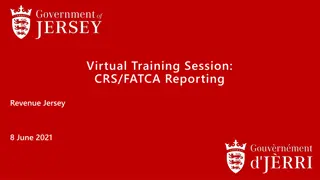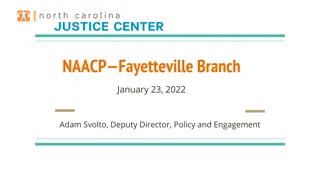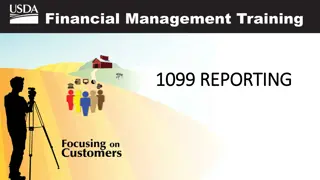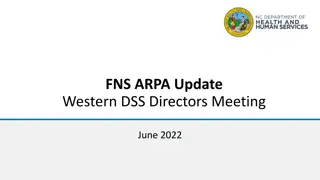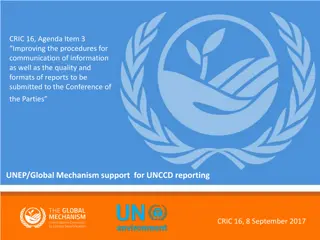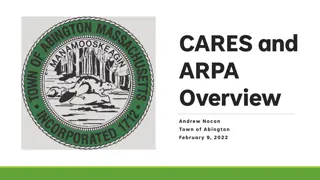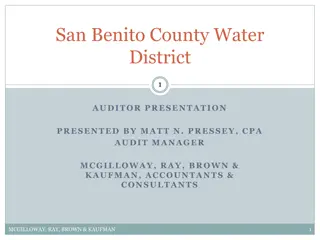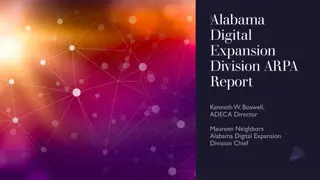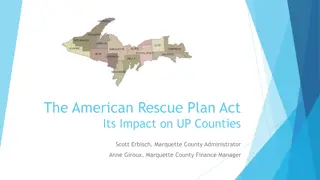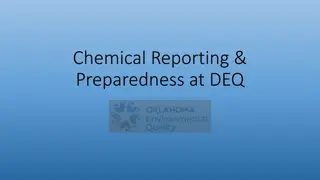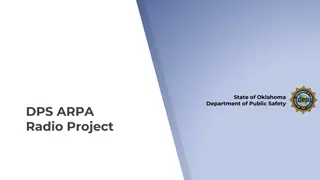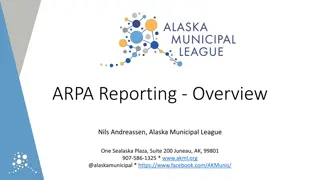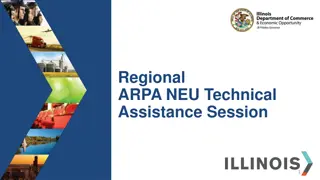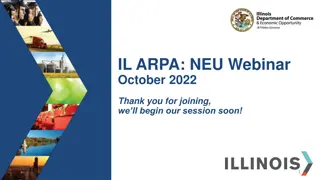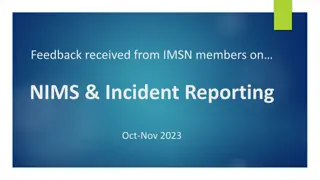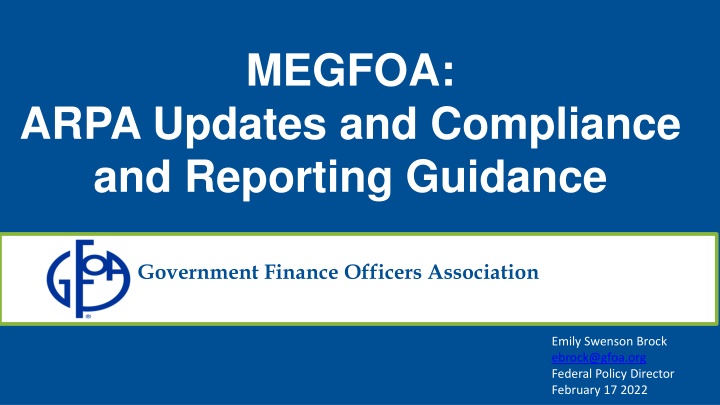
GFOA ARPA Guidelines for Effective Fund Allocation
Learn about the Government Finance Officers Association's guiding principles for the American Rescue Plan Act (ARPA), including temporary nature of ARPA funds, strategic investment in critical infrastructure, partnering efforts with local jurisdictions, and careful consideration for fund allocation. Explore the key updates and compliance strategies to ensure optimal utilization of ARPA funds.
Download Presentation

Please find below an Image/Link to download the presentation.
The content on the website is provided AS IS for your information and personal use only. It may not be sold, licensed, or shared on other websites without obtaining consent from the author. If you encounter any issues during the download, it is possible that the publisher has removed the file from their server.
You are allowed to download the files provided on this website for personal or commercial use, subject to the condition that they are used lawfully. All files are the property of their respective owners.
The content on the website is provided AS IS for your information and personal use only. It may not be sold, licensed, or shared on other websites without obtaining consent from the author.
E N D
Presentation Transcript
MEGFOA: ARPA Updates and Compliance and Reporting Guidance Government Finance Officers Association Emily Swenson Brock ebrock@gfoa.org Federal Policy Director February 17 2022
Roadmap oPart 1: ARPA and Final Rule Updates oPart 2: Compliance and Reporting 2
GFOA ARPA Guiding Principles o Temporary Nature of ARPA Funds Care should be taken to avoid creating new programs or add-ons to existing programs that require an ongoing financial commitment. Use of ARPA funds to cover operating deficits caused by COVID-19 should be considered temporary and additional budget restraint may be necessary to achieve/maintain structural balance in future budgets. Investment in critical infrastructure is particularly well suited use of ARPA funds because it is a non-recurring expenditure that can be targeted to strategically important long- term assets that provide benefits over many years. However, care should be taken to assess any on-going operating costs that may be associated with the project. 4
GFOA ARPA Guiding Principles o ARPA Scanning and Partnering Efforts Local jurisdictions should be cognizant of state-level ARPA efforts, especially regarding infrastructure, potential enhancements of state funding resources, and existing or new state law requirements. Consider regional initiatives, including partnering with other ARPA recipients. It is possible there are many beneficiaries of ARPA funding within your community, such as schools, transportation agencies and local economic development authorities. Be sure to understand what they are planning and augment their efforts or create cooperative spending plans to enhance the structural financial condition of your community. 5
GFOA ARPA Guiding Principles o Take Time and Careful Consideration Use other dedicated grants and programs first whenever possible and save ARPA funds for priorities not eligible for other federal and state assistance programs. Whenever possible, expenditures related to the ARPA funding should be spread over the qualifying period (through December 31, 2024) to enhance budgetary and financial stability. Adequate time should be taken to carefully consider all alternatives for the prudent use of ARPA funding prior to committing the resources to ensure the best use of the temporary funding. 6
Eligible Expenditures: Four Main Categories A.COVID-19 or a negative economic impact B.Premium pay for eligible workers C.For government services to the extent of the loss of revenue D.Investments in water, sewer and broadband infrastructure 8
FINAL RULE ISSUED o Final rule issued January 7, 2022 oThe final rule takes effect on April 1, 2022 If a use of funds complies with the final rule, Treasury will not take action to enforce the interim final rule, regardless of when the funds were used (e.g., if the IFR would not permit that use of funds); recipients can take advantage of the expanded flexibilities in the final rule now Until April 1, the interim final rule remains in effect; funds used consistently with the IFR while it is in effect are in compliance with the SLFRF program 9
Prohibitions Further Clarified Restriction Reduction in tax revenue SLFRF may not be used to directly or indirectly offset a reduction in net tax revenue resulting from a change in state or territory law, as required by the American Rescue Plan Deposits into Pension Funds SLFRF may not be used for deposits into pension funds, as required by ARPA A deposit is defined as an extraordinary contribution to a pension fund for the purpose of reducing an accrued, unfunded liability Recipients may use funds for routine payroll contributions to pensions of employees whose wages and salaries are an eligible use Other Restrictions on Use Funds may not be used for debt service, replenishing rainy day funds/financial reserves, or satisfaction of a settlement or judgment May not undermine mitigation practices in line with CDC guidance and recommendations Uses of funds may not violate Uniform Guidance conflict-of-interest or other applicable laws Revenue Loss Generally, funds available under the revenue loss eligible use category can be used to meet the non-federal cost-share or matching requirements of other federal programs Except that funds may not be used as the non-federal share for a state s Medicaid and CHIP programs, even under the revenue loss eligible use category Except when a federal statute specifically and/or expressly permits FRF to be used as match (e.g., IIJA permits FRF as match on certain broadband deployment projects) 11
A. Public Health & Negative Economic Impacts Services to Disproportionately Impacted Communities Public Health Negative Economic Impacts COVID-19 Vaccination Household Assistance: Food Programs Education Assistance: Early Learning Household Assistance: Rent, Mortgage, and Utility Aid COVID-19 Testing Education Assistance: Aid to High-Poverty Districts COVID-19 Contact Tracing Household Assistance: Cash Transfers Education Assistance: Academic Services Prevention in Congregate Settings (Nursing Homes, Prisons/Jails, Dense Work Sites, Schools, etc.) Household Assistance: Internet Access Programs Education Assistance: Social, Emotional, and Mental Health Services Personal Protective Equipment Household Assistance: Eviction Prevention Education Assistance: Other Medical Expenses (including Alternative Care Facilities) Unemployment Benefits or Cash Assistance to Unemployed Workers Healthy Childhood Environments: Child Care Capital Investments or Physical Plant Changes to Public Facilities that respond to the COVID-19 public health emergency Job Training Assistance (e.g., Sectoral job- training, Subsidized Employment, Employment Supports or Incentives) Healthy Childhood Environments: Home Visiting Other COVID-19 Public Health Expenses (including Communications, Enforcement, Isolation/Quarantine) Healthy Childhood Environments: Services to Foster Youth or Families Involved in Child Welfare System Contributions to UI Trust Funds Payroll Costs for Public Health, Safety, and Other Public Sector Staff Responding to COVID-19 Small Business Economic Assistance (General) Healthy Childhood Environments: Other Mental Health Services Aid to Nonprofit Organizations Housing Support: Affordable Housing Substance Use Services Aid to Tourism, Travel, or Hospitality Housing Support: Services for Unhoused Persons Other Public Health Services Aid to Other Impacted Industries Housing Support: Other Housing Assistance Other Economic Support 13 Rehiring Public Sector Staff
Final Rule: Responding to COVID-19 Expanded and clarified eligible uses, including: Making affordable housing, childcare, early learning services, and services to address learning loss eligible to all impacted households Clarifying eligible uses in disproportionately impacted communities, including certain community development and neighborhood revitalization activities Clarifying eligible uses for disproportionately impacted small businesses, including rehabilitation of commercial properties and start-up or expansion assistance Presumed Populations: Defines low- and moderate-income households and communities presumed impacted by the pandemic Presumes low-income households and communities disproportionately impacted, in addition to Qualified Census Tracts and others Presumes small businesses and non- profits operating in Qualified Census Tracts disproportionately impacted, among others 14
Final Rule: Eligibility Criteria o In general, to identify eligible uses of funds in this category, recipients should (1) identify a COVID-19 public health or economic impact on an individual or class (i.e., a group) and (2) design a program that responds to that impact. 15
Final Rule: Public Sector Capacity Public safety, public health, and human services staff Payroll and covered benefits for public safety, public health, health care, human services and similar employees of a recipient government through the period of performance Limited to the portion of the employee s time spent responding to COVID-19, though public health and safety staff primarily dedicated to COVID-19 response may be fully covered; recipients can use reasonable estimates to determine share of employee time Government employment & rehiring public sector staff Restoring employment by hiring up to 7.5% above pre-pandemic baseline Funding for employees who experienced pay reductions or were furloughed Maintaining current compensation levels to prevent layoffs Worker retention incentives, including reasonable increases in compensation Effective service delivery Supporting use of evidence, program evaluation, data, and outreach Providing administrative expenses for administration of programs that respond to COVID-19 Address administrative needs caused or exacerbated by the pandemic (e.g., backlogs from pandemic shutdowns, adapting government operations to the pandemic) 16
Final Rule: Capital Expenditures Overall eligibility requirements Capital expenditures subject to same related and reasonably proportional standard as other uses Recipients other than Tribal governments must complete Written Justification (WJ) for capital expenditures at or over $1 million WJ requires recipients to explain why a capital expenditure is appropriate and why the proposed capital expenditure is superior to alternatives Depending on project size, recipients may be required to submit WJ with reporting; no pre-approval Presumptions for capital expenditures Projects presumed eligible, provided the above requirements are met: Testing labs and equipment Emergency operations center & equipment Affordable housing Childcare facilities Schools (for Disproportionately Impacted communities) Primary care health clinics and hospitals (for Disproportionately Impacted communities) Projects generally presumed to be ineligible: Construction of new correctional facilities as a response to an increase in rate of crime Construction of new congregate facilities to decrease spread of COVID-19 in facility Construction of convention centers, stadiums or other large capital projects for general economic development or aid to impacted industries 17
IRS Updated Guidance On November 17, the IRS updated guidance regarding requirements for SLFRF payments to individuals. Click here to see the IRS Guidance. This key guidance includes: Payments to individuals from SLFRF for utilities (or arrearages of utilities) is NOT considered income and therefore a Form 1099-MISC is not required. Other cash transfers to individuals is not income, and therefore no Form 1099-MISC or other information return is required to be filed with the IRS or furnished to the recipient. 18
B. PREMIUM PAY Public Sector: Public health and safety staff Eligible Worker: Staff at nursing homes, hospitals, home care settings Needed to maintain continuity of operations of essential critical infrastructure sectors, including . Childcare workers, educators, and other school staff Social service and human services staff any work performed by an employee of a State, local, or Tribal government . Premium Pay: An amount up to $13 per hour in addition to wages or remuneration the worker otherwise receives and in an aggregate amount not to exceed $25,000 per eligible worker. Private Sector (grants to other employers): Workers at farms, food production facilities, grocery stores, and restaurants Essential Work: Can be provided directly, or through grants to private employers to public health/safety staff and essential workers outside the public sector: Work that is not performed while teleworking from a residence and, Janitors and sanitation workers Truck drivers, transit staff, and warehouse workers Involves regular in-person interactions with patients, the public, or coworkers of the individual that is performing the work or; Regular physical handling of items that were handled by, or are to be handled by patients, the public, or coworkers of the individual that is performing the work. NOTE: The chief executive officer can designate any other sectors determined as critical to protect the health and well-being of the residents. 20
Final Rule Additions o Eligible workers are those in critical infrastructure sectors o Essential work involves regular in-person interactions or physical handling of items handled by others o Pay must respond to worker needs: o Serves workers who: o Earn at or below 150 percent of their state or county s average annual wage, or o Are not exempt from Fair Labor Standards Act overtime rules o Or recipient provides written justification of how it meets needs 21
Final Rule Additions 1. Identify an eligible worker who are needed to maintain continuity of operations of essential critical infrastructure sectors. 2. Verify that the eligible workerhas maintained essential work in-person 3. Confirm that the premium pay responds to workers performing essential work during the covid-19 public health emergency 1. Is not exempt from the Fair Labor Standards Act overtime provisions 2. Is earning at or below 150 percent of their residing state or county s annual wage 3. If does not meet above criteria, then submit written justification 22
EXAMPLE: King City, Oregon (Pop: 4,408) o State of Oregon Annual Average wage for all occupations = $55,349 o Washington County Annual Average wage for all occupations = $73,226 $73,226 x 150% = $109,839 In the case of King City there are only 2 employees that would exceed that figure with the addition of the Premium Pay. o Brief Narrative: As a small City with a limited tax base we are limited on what we can pay in salary. Most of our salaries are 1-2 thousand dollars a month lower that our neighboring City s. We lack the ability to offer higher wages due to budgetary constraints and restrictions on tax adjustments. The City spends significant resources constantly hiring and retraining employees who leave for higher paying jobs that require less of the time and dedication. Retention is a significant problem for a small city. Regardless of the employee s pay or position within our organization, every employee has worked the front line throughout this pandemic. o Staff is proposing to limit the Premium Pay from $13 p/hr worked to $10 p/hr worked either directly or in support of the City s Covid related response from April 1, 2020 when the emergency was first declared through the end of September 2021 in the following sectors: o public service, public health, public safety, public welfare, public infrastructure, parks, maintenance, positions that support the continuity of the City s essential operations. 23
IRS Updated Guidance On November 17, the IRS updated guidance regarding requirements for SLFRF payments to individuals. Click here to see the IRS Guidance. This key guidance includes: Premium pay amounts paid to employees are considered wages. Employers generally must withhold federal income tax as well as social security tax and Medicare tax from employees' wages. (Employers also may have to pay federal unemployment tax on the wages.) Any payment from SLFRF that is in the nature of compensation for services, even a one-time payment (such as a hiring bonus ), is considered wages. 24
Final Rule Additions o Recipients may determine their revenue loss by choosing between two options: A standard allowance of up to $10 million in aggregate, not to exceed your award amount, during the program Calculating your jurisdiction s specific revenue loss each year using Treasury s formula, which compares actual revenue to a counterfactual trend. 26
What is Revenue? o What is OUT of the revenue calculation: Federal transfers (even those flowing through the State) (IFR) Intergovernmental transfers from your entity to your entity (Census p. 45) Refunds and other correcting transactions (IFR) Proceeds from the issuance of debt (IFR) Must adjust actual revenue totals for the effect of tax cuts and tax increases that are adopted after January 6, 2022 o What is IN? Governments may elect to include revenues from utilities (water supply, electric power, gas supply, and public mass transit systems) Census p. 65 Everything not listed above taxes, fees and other revenues to support public services Including Fees generated by the underlying economy Component units and enterprise funds civic center, zoo, parking, ports, sports stadiums etc. etc. etc. 27
Process for Revenue Replacement o Look at the past 2019 base year revenue o Recipients average annual growth of the past three fiscal years Apply 5.2% growth rate or greater to annual revenues collected o Multiplier applies to the revenue collected in each calendar or each fiscal year Choice is up to the issuer Must be consistent throughout the period of performance o Compare projected growth revenue to actuals collected If actual exceeds projected, collection is zero for that year 29
C. Revenue Loss Provision of Government Services (can include, but are not limited to): Restrictions: Paying interest or principal on outstanding debt Maintenance or pay-go funded building of infrastructure/roads Replenishing rainy day or other reserve funds Modernization of cybersecurity, including hardware, software, and protection of critical infrastructure. Paying settlements or judgments would not be considered provision of a government service, since these uses of funds do not entail direct provision of services to citizens Health services Environmental remediation School/educational services Provision of police, fire, and other public safety services 30
Major Procurement Considerations o Be careful of any of the recaptured revenue placed in the General Fund Still SLFRP funding Still subject to Uniform Guidance Still subject to the bounds of the law o SEFA reporting is required when the expenditure occurs 31
D. Water/Sewer Necessary investments in projects that: Improve access to clean drinking water. Improve wastewater and stormwater infrastructure systems. Provide access to high-quality broadband service. Necessary Investment: Designed to provide an adequate minimum level of service and are unlikely to be made using private sources of funds. Give priority to those most in need
Final Rule Additions o Invest in water, sewer, and broadband infrastructure, making necessary investments to improve access to clean drinking water, to support vital wastewater and stormwater infrastructure, and to expand affordable access to broadband internet. Recipients may fund a broad range of water and sewer projects, including those eligible under the EPA s Clean Water State Revolving Fund, EPA s Drinking Water State Revolving Fund, and certain additional projects: Broader set of lead remediation projects, including faucets, fixtures, and internal plumbing in schools and childcare facilities Additional types of stormwater infrastructure, such as culverts Residential wells Certain dam and reservoir rehabilitation 34
D. Water/Sewer CWSRF List of State Contacts DWSRF List of State Contacts
D. Broadband Build broadband infrastructure with modern technologies in mind, specifically projects that deliver services offering: Reliable 100 Mbps download and 100 Mbps upload speeds, unless impracticable due to topography, geography, or financial cost. Broadband Assisting underserved households and businesses: Meet household/business needs, such as: Ability to work from home, receive education online, use health applications online etc. Broadband: Last Mile projects Broadband: Other projects Treasury interprets businesses in the context of Broadband Infrastructure broadly to include: Non-residential users of broadband, including private businesses and institutions that serve the public, such as schools, libraries, healthcare facilities, and public safety organizations. 36
Final Rule Additions o Invest in water, sewer, and broadband infrastructure, making necessary investments to improve access to clean drinking water, to support vital wastewater and stormwater infrastructure, and to expand affordable access to broadband internet. Recipients may fund high-speed broadband infrastructure in areas of need that the recipient identifies, such as areas without access to adequate speeds, affordable options, or where connections are inconsistent or unreliable: Under the IFR, recipients were required to invest in households and businesses without reliable wireline 25/3 Mbps Final rule broadens flexibility by encouraging recipients to invest in locations without reliable wireline 100/20 Mbps but enables recipients to identify additional need for investment (e.g., affordability) Final rule also adds an affordability requirement 37
Procurement Questions o Recipients do not need approval from Treasury to determine whether an investment in a water, sewer, or broadband project is eligible under the SLFRF. Each recipient should review the IFR in order to make its own assessment of whether its intended project meets the eligibility criteria in the IFR. o Major procurement considerations include Davis Bacon Requirements (and/or project labor agreements) Employees and contractors working on the project Technology minimum standards 38
Key Procurement Responsibilities #1: Treasury Resources Treasury s Main SLFRF Page NEU Homepage Interim Final Rule FAQs (Main) FAQs (on Distribution of Funds to NEUs) Non-entitlement Unit of Local Government Checklist for Requesting Initial Payment Award Terms and Conditions for Non- entitlement Units of Local Government Assurances of Compliance with Title VI of the Civil Rights Act of 1964 Status of Payments to States for Distribution to Non-entitlement Units of Local Government Compliance and Reporting GFOA Resources Coronavirus Response Resource Center Analysis of the American Rescue Plan ARPA Revenue Replacement Calculator GFOA Guiding Principles 42
Key Procurement Responsibilities #2: Know your Uniform Guidance, including 2CFR200 and compliance supplements Properly documented policies Understand key waiver thresholds including sole source and micro purchases, otherwise purchases must conform, including competitive requirements Treasury has NOT issued any uniform guidance waivers for expenditures in any category.
Key Procurement Responsibilities #3: Know your Single Audit Eligibility and monitor SEFA activity The Uniform Guidance requires non-Federal entities that expend $750,000 or more a year in Federal awards to have an audit conducted in accordance with the Uniform Guidance. Talk with your auditor early about SEFA reporting requirements and how to report those expenditures GFOA Advanced Accounting Academy
Key Procurement Responsibilities #4: Sub-recipient Monitoring Recipients: Eligible entities identified in sections 602 and 603 that received a CSLFRF award: States and the District of Columbia, Territories, Tribal governments, Counties, Metropolitan cities, Non- entitlement units, or smaller local governments. Sub-recipients: Entities that receive a sub-award from a recipient to carry out the purposes (program/project) of the award on behalf of the recipient. Recipientsare responsible for sub-recipient monitoring: Clearly identify to the sub-recipient that the award is CSLFRF. Identify all compliance requirements and any reporting requirements. Initial and ongoing evaluation of each sub-recipients risk of noncompliance. Develop written policies and procedures for sub-recipient monitoring and risk evaluation as well as sufficient document retention policies.
Key Procurement Responsibilities #4: Sub-recipient Monitoring Subawards Specific information required for each subaward (Contract, Grant, Loan, Transfer, or Direct Payment) greater than or equal to $50,000 Aggregate reporting is required for contracts, grants, transfers made to other government entities, loans, direct payments, and payments to individuals that are below $50,000. This information will be accounted for by expenditure category at the project level.
Key Procurement Responsibilities #5: o EC must be used to categorize each project. o *symbol denotes areas where recipients must identify the amount of the total funds that are allocated to evidence-based interventions. o ^symbol denotes areas where recipients must report on whether projects are primarily serving disadvantaged communities. o Project demographic distribution

